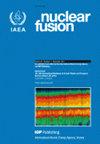在 ASDEX 升级中对不利 B T 条件下的高辐射氮封 H 模式等离子体进行表征
IF 4
1区 物理与天体物理
Q1 PHYSICS, FLUIDS & PLASMAS
引用次数: 0
摘要
在 ASDEX 升级托卡马克(AUG)中对不利 BT 条件下的高辐射氮封 H 模式等离子体进行了表征。向一个完全分离的 H 模式等离子体注入了三个级别的氮气膨化率,该等离子体以离子漂离 X 点的较低单空配置运行。氮气注入后,在 X 点附近立即形成了一个冷(eV)高辐射()区,这一点可以从分流汤姆逊散射(DTS)测量和二维波长测量重建中得到证明。此外,随着氮气膨化率的增加,辐射器沿着高场侧(HFS)的分离矩阵在 X 点上方进一步向上移动,这一点可以通过绝对扩展紫外(AXUV)测量得到证明。高辐射机制的形成与改良分流器等离子体条件密切相关。沿着DTS测量的视线,电子温度降低到几个eV,最初在X点附近,随着辐射器的向上运动,电子温度进一步延伸到HFS刮除层(SOL),然而,在低场侧(LFS)SOL,电子温度维持在(eV),电子密度略有下降。高辐射体制显示出 LFS/HFS 分流器的不对称性,这与有利 BT 条件下的 H 模式等离子体相反,表明漂移在 AUG 高辐射 X 点体制的形成中起了重要作用。中性粒子通量在私人通量区显著增加(系数为 ),而在主室则略有增加( ),这表明随着高辐射体制的形成,二分器下中性压缩增强。此外,随着基座内部电子温度的进一步提高,基座电子密度也出现了下降,而通过持续等离子体约束的氮气播种,实现了憩室的完全脱离。最后,通过 SOLPS-ITER 模型分析了氘和氮离子的粒子源和流动模式,证实了漂移在 AUG 的不利 BT 中形成高辐射状态的重要作用。本文章由计算机程序翻译,如有差异,请以英文原文为准。
Characterization of highly radiating nitrogen-seeded H-mode plasmas in unfavorable B T at ASDEX Upgrade
The highly radiating nitrogen-seeded H-mode plasmas in unfavorable BT has been characterized in the ASDEX Upgrade tokamak (AUG). Three levels of nitrogen puffing rates have been injected into a fully detached H-mode plasma, which is run in lower single null configuration with the ion drift away from the X-point. A cold ( eV) highly radiating ( ) region forms close to the X-point immediately after nitrogen seeding, as evidenced by measurements of the divertor Thomson scattering (DTS) and the two-dimensional bolometry reconstructions. In addition, the radiator moves further upwards above the X-point along the separatrix at the high-field side (HFS) with increasing nitrogen puffing rates, as evidenced by the Absolute eXtended UltraViolet (AXUV) measurements. The formation of the highly radiating regime is closely correlated to the modifications of the divertor plasma conditions. Along the line of sight of the DTS measurement, the electron temperature reduces down to a few eV, which initials near the X-point and further extends to the HFS scrape-off layer (SOL) simultaneously with the upward movement of the radiator, however, the electron temperature sustains ( eV) at the low-field side (LFS) SOL with slightly decreased electron density. The highly radiating regime shows LFS/HFS divertor asymmetry, in contrast to that for H-mode plasmas in favorable BT, suggesting that the drifts play an important role for the formation of the highly radiating X-point regime at AUG. The neutral particle flux increases significantly (factor of ) in the private flux region, while it increases slightly ( ) in the main chamber, thus suggesting an enhanced sub-divertor neutral compression with the formation of the highly radiating regime. Furthermore, a degradation of the pedestal electron density was observed with an enhancement of the electron temperature further inside the pedestal, and complete divertor detachment was achieved by nitrogen seeding with sustained plasma confinement. Finally, particle sources and flow patterns of deuterium and nitrogen ions have been analyzed by SOLPS-ITER modelling, confirming that the drift plays an important role for the formation of the highly radiating regime in unfavorable BT at AUG.
求助全文
通过发布文献求助,成功后即可免费获取论文全文。
去求助
来源期刊

Nuclear Fusion
物理-物理:核物理
CiteScore
6.30
自引率
39.40%
发文量
411
审稿时长
2.6 months
期刊介绍:
Nuclear Fusion publishes articles making significant advances to the field of controlled thermonuclear fusion. The journal scope includes:
-the production, heating and confinement of high temperature plasmas;
-the physical properties of such plasmas;
-the experimental or theoretical methods of exploring or explaining them;
-fusion reactor physics;
-reactor concepts; and
-fusion technologies.
The journal has a dedicated Associate Editor for inertial confinement fusion.
 求助内容:
求助内容: 应助结果提醒方式:
应助结果提醒方式:


